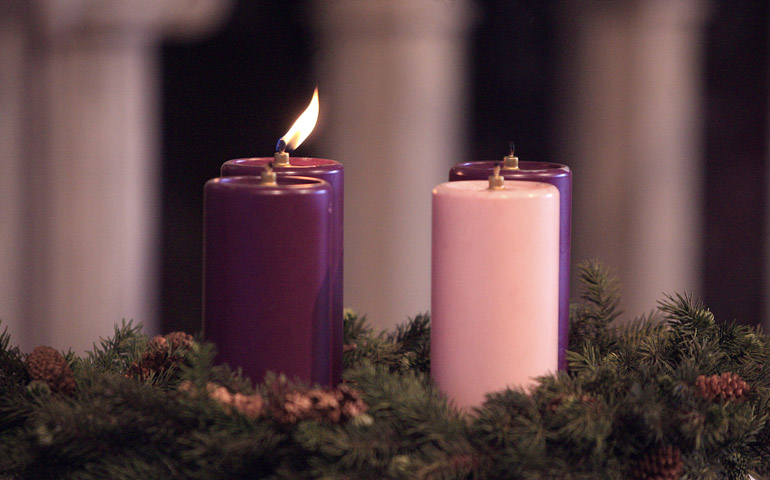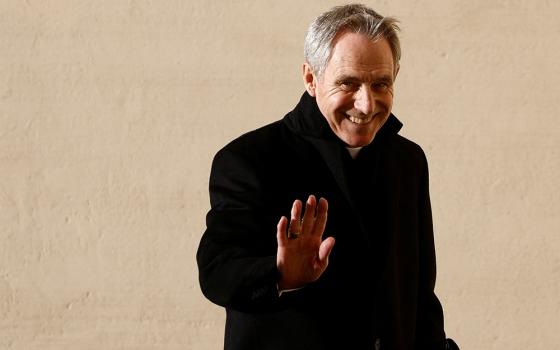
A lit candle in the Advent wreath at St. John Vianney Church in Prince Frederick, Md., marks 2009's first Sunday of Advent. (CNS/Bob Roller)
This week, Christians begin a new liturgical year and enter into the rich and ancient four-week season of Advent. For most American Christians, Advent passes virtually unnoticed, as the celebration of "Christmas" as a secular and intensely commercial feast begins the day after Thanksgiving. Yet the time of Advent offers us an opportunity to dive deeply into a counter-cultural time of quiet reflection, a space of hopeful and patient waiting and discernment about how God's incarnation has meaning and is at work in our world today.
Before the middle of the fourth century, there were no liturgical seasons, such as Advent or Lent, or any idea of a "liturgical year," something many Christians take for granted today. The great Paschal Easter feast was the central focus of the Christian year, along with the Sunday gatherings, considered "little Easters." Advent is first noted around the year 350, about the same time Christmas is first mentioned as being celebrated. The date of Christmas might well have been placed near the winter solstice as a replacement to the pagan solstice celebrations of the Roman Empire.
The liturgical year, with its broad seasons of Advent-Christmastide and Lent-Eastertide, evolved within this world of the Roman Empire -- a northern hemispheric world. People living in the empire identified and adapted parallels between the natural world they inhabited and the words, music and images of their sacred time in worship. As the daylight dwindled, they yearned and leaned toward the return of light. And as they saw God's hand in the rhythm of the seasonal changes, they believed and proclaimed that the birth of Jesus, "the light of the world," would herald that longed-for return of light that presaged God's reign of peace and harmony (Isaiah 2:1-5, from Advent 1 in the "A" cycle).
|
First Sunday of Advent Jeremiah 33:14-16 |
As in the other yearly liturgical cycles, the readings of this Advent season reflect a movement through the four weeks from an apocalyptic and cosmic in-breaking of God in the first Sundays to the more intimate stories, including Mary as a central figure, in the fourth Sundays that prepare us for God's incarnation in the most unexpected and unpredictable manner -- as an infant in an occupied country to a poor and unwed teenager.
All three of the readings this Sunday are messages of encouragement and future hope. Jeremiah prophesies to Israel and Judah that God's appointed one will bring in a reign of justice, righteousness and safety. Paul, writing to the fledgling Christian community in Thessalonika (and believing, like them, that Christ's second coming was immanent), prays they might be strengthened in their faith and abounding in love as they patiently wait. While Jesus' words of warning in the Gospel might seem stern, they are not nearly as harsh as the same message from Mark (read last Advent). Jesus' encouragement in Luke's Gospel includes, "... [when these things take place] raise your head, because your redemption is drawing near." One of the challenges in choosing and introducing Advent music is to be faithful to be these texts with their diverse images while working to create a sense of prayerful engagement in the midst of a hectic time of the year.
Even though the carols and hymns of Advent are not as familiar as Christmas carols, there is a long, diverse and beautiful repertoire of texts and music available to us. When I was working full-time as a parish musician, I often dropped much or all of the instrumental accompaniment for the hymns, songs and chants at Mass through the entire season up to Christmas, just as all singing in worship was unaccompanied for more than the first thousand years of the church. Our planning team also tried to add more silence and less artificial lighting throughout worship. It was an attempt to reflect the quietness of the natural world and help people connect to the cycles of light and darkness. Many times, members of the community showed appreciation for creating a meditative and attentive space within worship during a time when the rest of life was filled with activities, responsibilities and events.
"Conditor Alme Siderum" ("Creator of the Stars of Night") is a beautiful Advent hymn used by religious communities for Vespers services in Advent. The original text dates to the sixth or seventh century, set to a lilting and gentle chant. The text was substantially revised in the 17th century; however, the first few lines provide a beautiful echo of both Jeremiah's vision and Jesus' call to be aware.
Here are the first lines of the original Latin and a prose translation:
|
Conditor alme siderum, aeterna lux credentium, Christe, redemptor omnium, exaudi preces supplicum. |
Loving Creator of the stars, eternal Light of believers, O Christ, redeemer of all, hear the prayers of supplicants. |
"My Soul in Stillness Waits" was written at my first full-time job as a parish music director. I wanted both the music and the text to quiet and deepen our sense of waiting within worship. The text is a very loose adaptation of the "O" antiphons (best known in the hymn, "O Come, O Come Emmanuel"), which were prayed in religious communities each evening of the week immediately before Christmas.
The music of Advent should reflect both the cosmic dimension of Christ's reign coming in its fullness (as proclaimed last week on Christ the King Sunday) and the immanence of an incarnate God, as close as our next breath. And so we begin this holy season, in which the secular world is as frantic as any time in the year, with strong messages of hope and a call (to Israel, to early Christians in Thessalonika, to Jesus' disciples, to us) for true awareness and a deepening of faith and love in our lives and in our communities.
[Marty Haugen is a composer of liturgical music for Roman Catholic and Protestant congregations, with more than 400 compositions published by GIA, Augsburg Fortress and other publishers.]



